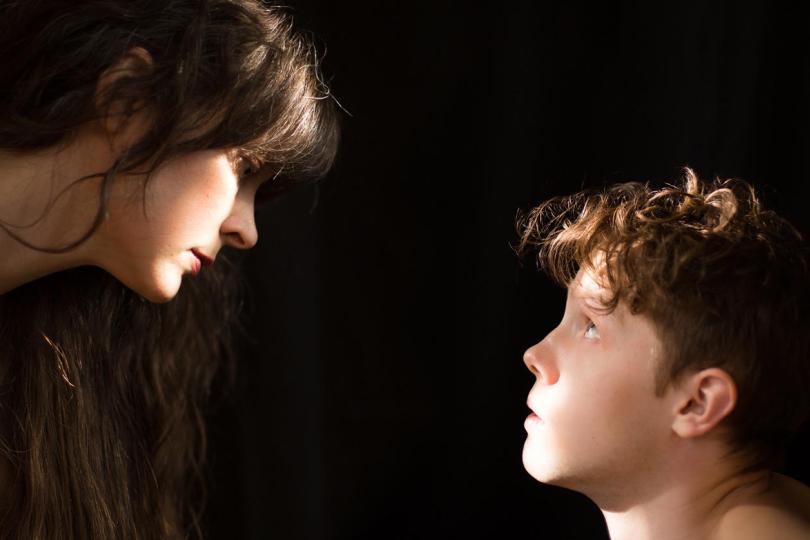"The Hollow" is Abstract for Good Reason

A theater company is producing a show. Should you expect a narrative? Trademark Theater, in their continuous effort to break the norm, says “no” with their genre-bending production of The Hollow.
The Hollow is a Concept Album/Contemporary Performance hybrid and marks Trademark’s third World Premiere. This multidisciplinary production explores the dualities of human nature and the mysticism of the outdoors by combining live music, movement and stunning visuals. The Hollow is about confronting our demons, whether in our relationships, our own bodies, or our minds.
The mission of Trademark Theater is to challenge the boundaries of traditional theater-making while expanding the breadth of original theatrical works produced in Minnesota. With The Hollow, Trademark is interested in blending forms to create something new. An artistic “trademark”. This project looks to combine pop rock music and musicians with traditional theater and dance. But it didn’t start out this way. Trademark Theater has been working on this project in some way for three years. When they started it was a totally different idea.
The very first idea was a concept album performed live with movement as an adaptation of Sleepy Hollow (The Sleepy Hollow part has since faded off). In its first incarnation, Trademark Theater focused on a straight-forward telling of the plot. Then they did a performance workshop, which felt much more like a musical.There was a script and text that was spoken and a want to take a badass feminist take to bring new life to the outdated content.
One comment on the show heard during a post-workshop discussion really stuck out to the creative team was someone at the workshop told them that the music was a little too loud and “the music was distracting.” This thought strongly went against the original intent that they had to bring the music to the forefront; the team checked in with themselves. They observed that it is very common in theater and dance pieces that utilize live musicians on stage to have the musicians tucked away in a corner. Trademark did not want to hide and worked to really integrate the musicians and make sure they held equal weight in the space and in the story.
The next version of The Hollow was a concert, where the musicians were able to really develop a lot of the music. One particular challenge was the different energy and expectations from different audiences at different venues. Ultimately, Trademark Theater settled on an approach that feels more like a music hall -- people can have a drink, have a conversation, and still be hearing this music that's part of the telling of a very abstract story. This felt closer to their intention and that energy lead to this version of The Hollow.
The creative team, through their exploration with the piece this time around, decided the piece necessitated abstraction. They felt they had to make it abstract so they could tell a story that is interpretable by audiences and they can place their own narratives on top of it. They took the themes that they were drawn to in their scripted workshop version and extracted them into this new draft. By leaning into the abstractness, the weight of being a scriptwriter was lifted from the musicians and they leaned into how they best write lyrics; a more abstract and description focused verbal sharing. This lead to the arc of the show being driven by feeling and creating an environment to work and move in. The abstraction for Trademark Theater is an attempt to not be traditional and to explore new forms and modes, which aligns strongly with their mission. Trademark sees this as an invitation to explore and highlight the strengths of the artists that are in the room. A musical version would have been traditional, and that is not Trademark Theater.
The creative team believes that abstraction gets at the essence of something; it is the purest and most visceral form of that thing. When an audience can surrender and trust their own experience of what is happening, then they can get drawn in in a stronger way. They commented that If we saw a show like that, we would be able to talk about that for a while. Which leads to one of the biggest anticipated challenges Trademark Theater has on its hands with the show -- audience reception.
The team commented that it is easy for an audience to walk in and experience the show and think, “What the hell is that?” Trademark noted that “New Work + Expectations = Hard,” and often leads to the option to lean into that or recoile away from newer forms of work. Trademark hopes its producing history shows that they are interested in doing just about anything as long as it is pressing against some sort of boundary.
I attended a rehearsal for The Hollow, and the shared weight and respect for all aspects of performing was evident. In many instances I witnessed all the artists in the room had space to contribute to the conversation, and a large chunk of the rehearsal was dedicated to blocking a smooth way to quite literally bring the musicians front and center. It felt respectful and healthy and the room felt energized by the process of creating something different.
Even if it is a grand experience, abstract and strange, Trademark hopes that their audiences will continue to lean in and embrace the abstract and its strengths.
Lean in and see for yourself.
The Hollow premieres at The Tek Box in The Cowles Center for Dance and the Performing Arts on October 4th with preview performances on October 2nd and 3rd. October 10th will be a ASL/AD Performance and October 14th is a Pay What You Can Performance.


